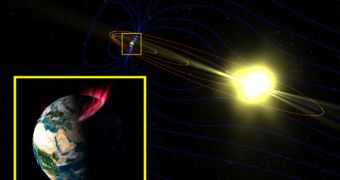The dynamics of explosive magnetic substorms, responsible for generating the aurora borealis and for the interferences affecting both satellites in Earth's orbit and electric and electronic devices on the surface, have now been revealed by NASA's five THEMIS spacecrafts, solving a mystery that has been a center of debate for the past three decades or so.
"We discovered what sparks the magnificent light show of the aurora," said THEMIS principal investigator Vassilis Angelopoulos of the University of California, Los Angeles.
With the help of the THEMIS probes, Angelopoulos and his research team detected the formation of substorms in the tail of the magnetosphere while monitoring the energy levels in Earth's magnetic field. The results of the measurements show that when the energy levels rise inside the magnetic field lines, the latter are pushed closer together until they are forced to reconnect, releasing relatively high amounts of energy which triggers a substorm.
"Our data show clearly and for the first time that magnetic reconnection is the trigger," said Angelopoulos, referring to the fact that scientists couldn't decide whether the substorms were determined by the reconnection of magnetic field lines or they would form closer to the ground.
The magnetic substorms were originally observed in the 19th century. They are determined by streams of charged subatomic particles coming from the Sun while interacting with the magnetic field of the planet. Part of the particles are trapped by the magnetic lines and are drawn into the atmosphere, where they energize the air, emitting electromagnetic radiation in several wavelengths of the optical spectrum, but not only.
Understanding the dynamics of this phenomenon is very important in predicting major space weather events that are not only capable of paralyzing satellites and power grids on the planet, but can also jeopardize the safety of astronauts into space.
"We need to understand this environment and eventually be able to predict when these large energy releases will happen so astronauts can go inside their spacecraft and we can turn off critical systems on satellites so they will not be damaged. To resolve this question properly requires correlations and signal-timing at multiple locations. This is precisely what was missing until now," Angelopoulos said.

 14 DAY TRIAL //
14 DAY TRIAL //